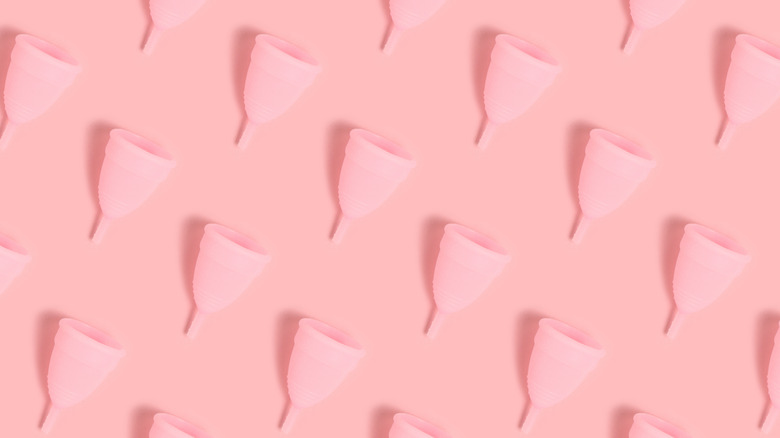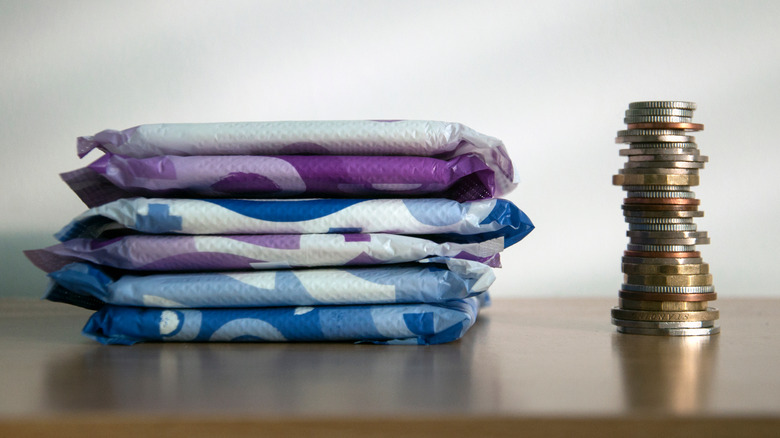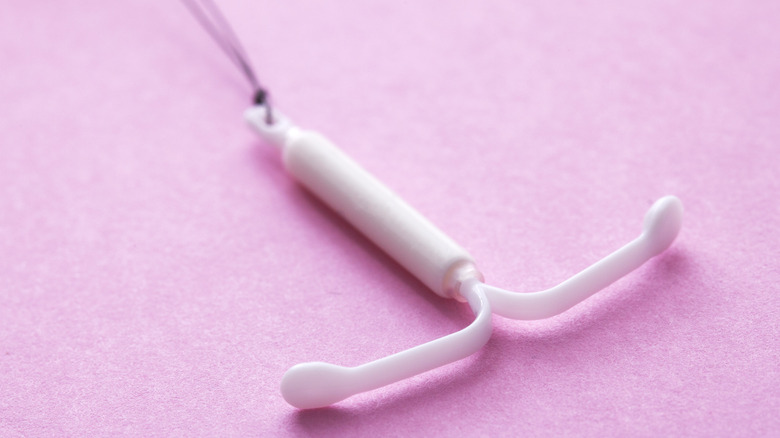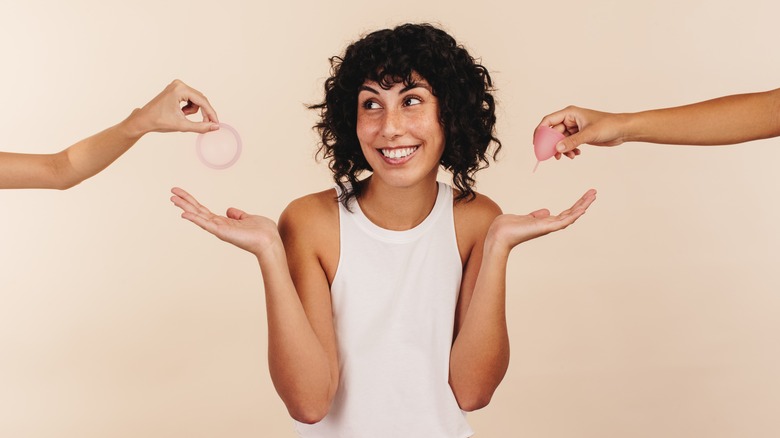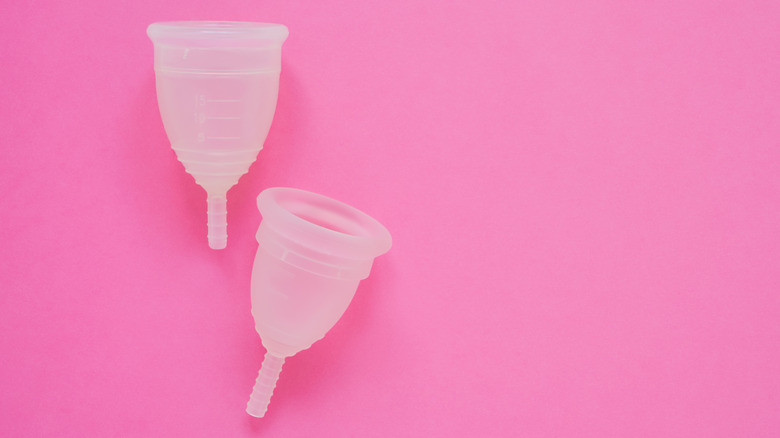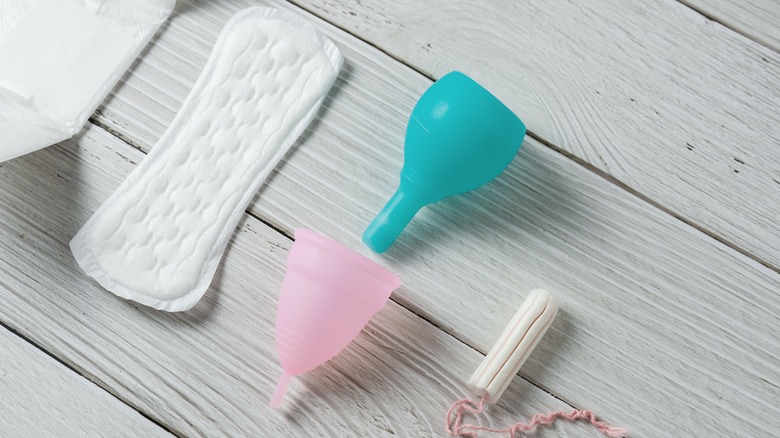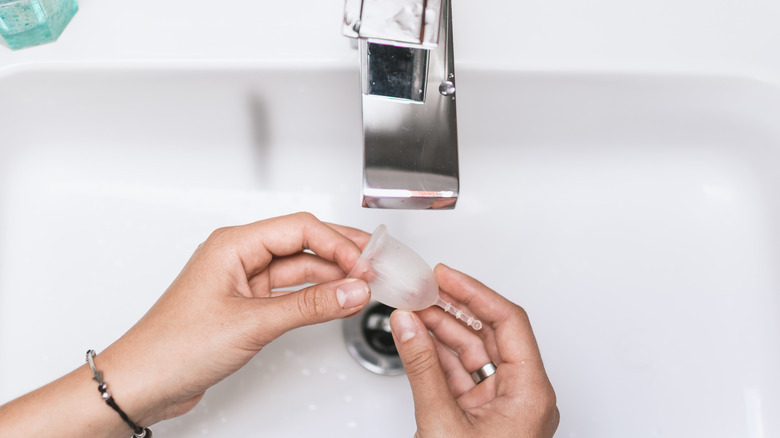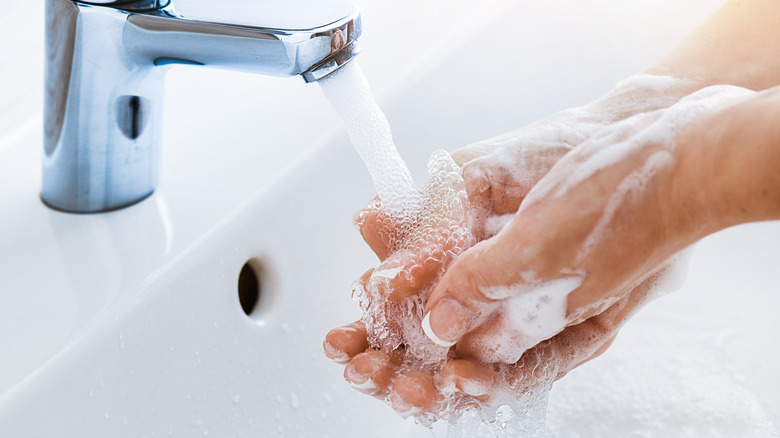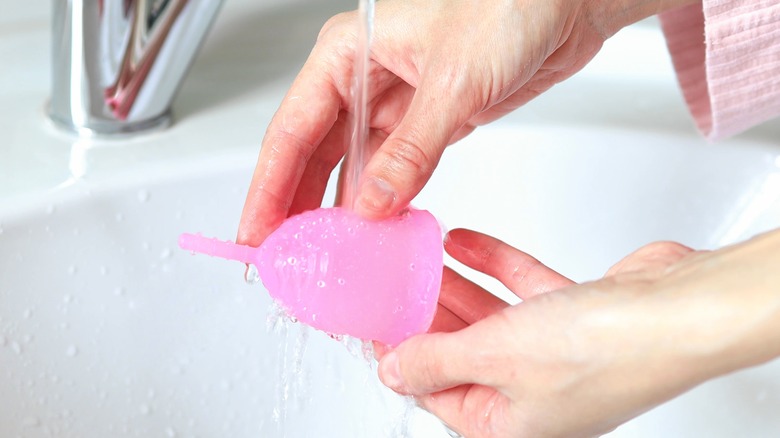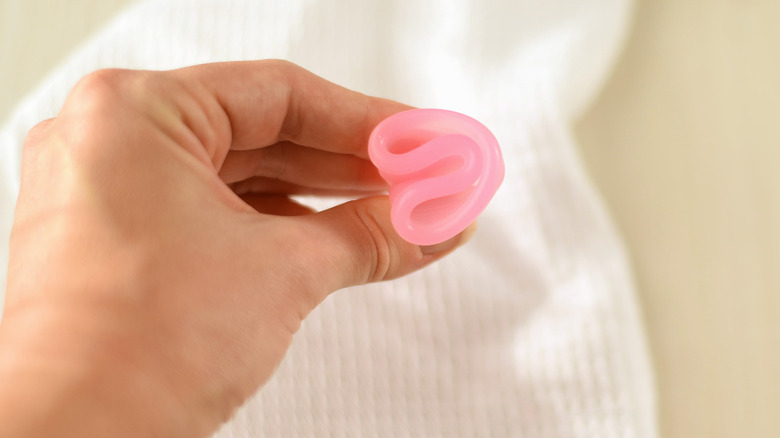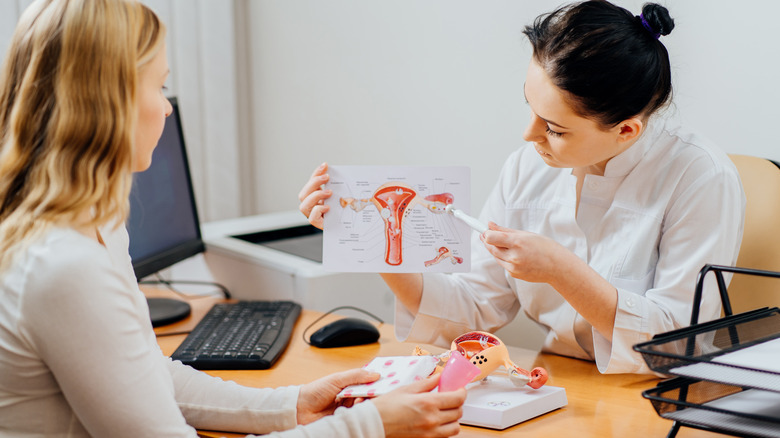Everything You Should Know Before Using A Menstrual Cup
Having a period can be such a hassle, with cramps, mood swings, bloating, and more — but what if you didn't have to add in a trip to the store to buy tampons? Meet the reusable menstrual cup, a flexible cup that collects your monthly flow. Simply insert, empty, rinse, wash, and repeat (via WebMD).
Menstrual cups have been proven to be safe and effective, and usually when you're using one, you can't feel a thing. It forms a seal along the lining of the vaginal wall, helping to prevent leaks. They were first invented in the 1930s, but didn't hit the American market until 1987, according to WebMD. Sales for menstrual cups keep going up, with totals expected to reach $1.89 billion by 2026 (via Cleveland Clinic).
These days, menstrual cups are going mainstream, and for good reason. According to a meta-analysis of research on menstrual cup usage, across 13 different studies an average of 73% of participants wanted to continue using them after the study (via The Lancet). That's a pretty successful conversion rate! However, as menstrual cups gain popularity, there are a few things you should know before jumping on the bandwagon. Let's dive into the pros and cons.
Menstrual cups are great for the environment
Let's face it — landfills are filled with tampons and pads. In the United States, approximately 12 billion pads and 7 billion tampons are thrown into the trash every year, according to Stanford Magazine. And unfortunately, not all of that trash makes it to the landfill; some ends up in our waterways and oceans. Have you heard of our eighth continent, the Great Pacific Garbage Patch? It's floating somewhere between California and Hawaii and has grown to be three times the size of France (via Iberdrola). It contains 80,000 tons of micro-plastics, possibly some of which came from plastic tampon applicators. It can take more than 20 years for tampon plastic to break down in the water, posing health risks to marine animals (per Stanford Magazine).
Some menstrual cup types are disposable, but most are reusable and can last for up to 10 years (via WebMD). In 10 years, one person would use and throw away an average of 3,200 tampons. If a menstruating person uses reusable cups their entire life, that means waste from 8,000-17,000 fewer tampons would exist in the world.
It's better for your wallet
Reusable cups usually cost anywhere from $30 to $40, according to WebMD. This might sound expensive compared to a $7 box of tampons, but when you factor in that you can reuse the menstrual cup for up to 10 years, that's a savings of about $800.
Not all reusable menstrual cups will last to year 10, but you should get at least 6 months of use out of them before you may consider buying a new one (via Healthline). The lifespan of your menstrual cup depends on several factors, including how you clean and care for it, as well as anatomical details like your vaginal pH and bacteria levels (via Divacup). To ensure your menstrual cup lasts, read the cleaning and care instructions thoroughly, as they can vary across brands.
Either way, you will be saving money as long as you use it for longer than 6 months; not to mention the saved time, energy, and gas money from all of those embarrassing and awkward emergency trips to the convenience store to grab tampons that you won't have to make anymore.
It works longer and better than a tampon
One of the bonuses of menstrual cups is that they hold more blood than a tampon. While you have to change a tampon every 4-8 hours, a menstrual cup can be used for up to 12 hours before you need to empty it (via Cleveland Clinic). Changing times will vary depending on how light or heavy your flow is, but menstrual cups can beat even a super-plus-ultra tampon. This is great for situations when you won't have easy access to a bathroom, like on a hike or long car ride.
Another plus is that menstrual cups have shown to not have a negative effect on your vaginal pH and beneficial bacteria. Along with your period blood, tampons absorb your vagina's natural fluids, which may disrupt the vaginal pH and bacteria balance, leaving you more vulnerable to yeast infections and bacterial vaginosis. Menstrual cups just collect your period blood, leaving your vaginal fluid intact to do its job.
Say goodbye to embarrassing odors
Your period can smell like many things, and the word "pleasant" isn't often used when describing these odors. These strong smells are most likely a result of your body shedding blood, tissues, and bacteria, which is all totally normal (via Healthline).
Unfortunately, when using pads (and sometimes tampons), your menstrual fluid is more likely to get exposed to air, leading to cringey smells that can make even the most confident woman feel uncomfortable (via Cleveland Clinic). Since a menstrual cup is entirely enclosed in the vaginal walls, there are no cotton strings or parts left uncovered and just waiting to do some damage on your poise.
If you ever notice odor changes or abnormal smells down below, schedule a visit with your doctor to make sure something more serious isn't going on. Potent smells, especially accompanied with other symptoms like pain or abnormal discharge, could indicate a possible infection or sexually transmitted disease (per Healthline).
You can use a menstrual cup with an IUD
There's good news for those who use intrauterine devices (IUDs) for birth control: According to Dr. Eleanor Rayner, "You can use a menstrual cup if you have an IUD" (via Healthline). However, you should use caution when combining the two.
There have been few studies on menstrual cups and IUDs, and the conclusions are conflicting. A 2012 survey published in the journal Contraception suggests there is no evidence linking menstrual cups with IUD expulsion, but a 2020 study "found higher than expected IUD expulsion rates in menstrual cup users" (via Obstetrics & Gynecology). It is important to keep in mind that IUD ejection can happen regardless of menstrual cup use, with contributing factors including age and heavy flow, according to Healthline.
When inserted, most menstrual cups stay low in the vagina, far away from the cervix and IUD strings. However, if you have a low cervix, the cup might end up closer to the IUD strings, and there is a chance the cup could pull on them. Some people choose to have the strings cut short, so this may not be an issue.
Overall, experts recommend waiting anywhere from 6 weeks to 3 months after IUD insertion before using a menstrual cup. If you have any hesitations, talk to your doctor about your cervix, IUD, and which menstrual cup would work best for your body.
You can still have sex (with the right kind of cup)
Finally — mess-free period sex. Maybe having sex on your period is just not your thing, and that's totally okay. But if it's something you've been missing — like you really want to have period sex without covering your bed in plastic trash bags — then listen up. You can have sex while a menstrual cup is inserted, but this isn't true of all menstrual cups. The reusable kind are not meant for use during sex; since they are made to be more durable and long-lasting, they would be uncomfortable or even harmful during sex (via Women's Health). Repeat: Do not use reusable menstrual cups during sex!
However, the disposable menstrual cups are where all the action is. Disposable cups are thinner and generally more flexible, so they can be worn during sex without causing discomfort. Some brands like Softdisc also sit higher up, closer to the base of the cervix, making sex doable while wearing one. Just don't count on menstrual cups to act as birth control or protect against sexually transmitted diseases — they are solely a period product (via Jack G. Faup, M.D.).
They come in different sizes
When it comes to menstrual cups, they are not one-size-fits-all. Most brands have two sizes to choose from, a small or large (via Healthline). Some brands even have 3 sizes (via Divacup).
Menstrual flow levels are not really considered when picking a cup size; it's more important to make sure the cup will fit right and stay in place. Generally, cup size is determined by the individual according to their age, body type, and life experience. If you've never had vaginal sex or given birth vaginally, the small cup size may be more appropriate for you. If you've experienced vaginal birth or have a weak pelvic floor, the large size may work better for you.
That said, these guidelines aren't all-inclusive, and the only way to truly know what menstrual cup will work best for your body is to pick a size and try it out. If you try a small and constantly have leaking issues, you may need to size up.
They come in different types and styles
There are two main types of menstrual cups: reusable and disposable. Actually, to be clear, the disposable ones are now often referred to as "discs." Which one is better? Well, that's up to you and your needs.
One brand of disposable menstrual discs, called Softdisc, can hold up to 5 tampons' worth of fluid, and you don't have to worry about rinsing and washing them to reuse. They do require a bit more effort to put in and take out though, since these don't come with a stem that helps with insertion and removal like the reusable ones (via Women's Health). However, for some it may be worth the extra effort, since you can have sex with them in and they claim to not cause dryness or irritation like reusable menstrual cups or tampons can (via Softdisc).
Most reusable cups are made with silicone, which is a relief for anyone with a latex allergy (via Women's Health). Different brands have slightly different styles, some with fancy removal stems and fun colors, but there's not a huge variation between them all. Some users find that if they've tried both sizes of a certain brand and are still experiencing leaking or other issues, switching brands does the trick. The range in styles can cause the cups to sit in the vagina in slightly different ways, which can alter their effectiveness depending on how your individual body is shaped. Variations in softness and firmness across brands can also affect those with sensitivities.
It's important to keep your menstrual cup clean
Cleaning directions vary across brands, but the big takeaway here is that it's vital to keep your reusable menstrual cup clean to reduce the risk of infections. Unfortunately, when using menstrual cups there is still a chance of toxic shock syndrome (TSS), a bacterial infection that can occur if a tampon stays in for too long or if a higher-absorbency tampon is used when it's not necessary (via Healthline). Though this condition is normally associated with tampons, there have been 5 reports of TSS due to menstrual cup usage as of 2019 (via The Lancet). Even though developing TSS is rare (and even more rare when using menstrual cups, according to Healthline), there are certain steps you can follow to reduce your risk. Always follow the instructions for proper care and cleaning, both during use and after use while your menstrual cup is in storage until next month. It's also a good practice to wash your hands with soap and warm water before inserting or emptying your cup.
They can be messy to insert and remove
You'll probably want to wash your hands after emptying and replacing your menstrual cup, as it can be a messy process (via Cleveland Clinic). For one thing, most cups require you to insert your fingers into your vagina to get the cup in and out (via Period Nirvana). Removing a full cup involves some obvious challenges — you'll want to be careful not to spill the period fluids before you can empty them into the sink or a toilet, otherwise you'll have to get out the mop. This process may take some practice to master. If you're still new to menstrual cups, Geisinger recommends possibly removing your cup in the shower until you've solidified your technique, though sitting over the toilet is also a good option.
The messiness can be a hinderance if you're in a situation where you don't have access to a private bathroom or sink, like when you're traveling. Some hacks regarding changing menstrual cups when not at home include bringing bottled water with you to the toilet to rinse your cup, using a wet wipe, or bringing along a spare clean menstrual cup to use if you don't want to re-insert the previous one (via Vulvani).
They can be hard to remove and replace
Taking out a menstrual cup takes a bit of practice. Instead of pulling on the stem when you want to remove it, it's better to pinch the bottom of the cup and carefully pull down, according to the Cleveland Clinic. You'll probably want to be in a bathroom with easy access to the sink, since most brands recommend emptying the cup into a sink or toilet, then rinsing and cleansing it before reinserting (via Healthline). This makes it a little more challenging to empty your cup in a public restroom, and can seem nearly impossible if your only option is a port-a-potty — but it can be done with a little practice and planning. And even though you can wear a menstrual cup for long periods of time, Healthline recommends you remove and clean your cup after 12 hours of use to help protect against bacterial proliferation.
Finding the right fit can be frustrating
Because everyone's body is different, some find menstrual cups easy to use, while others find it a challenge. For some people, it's hard to find the right fit because their anatomy might affect the way the cup sits in the vagina. According to gynecologist Erin Higgins, a menstrual cup may not fit well if you have a dropped uterus or uterine prolapse (via Cleveland Clinic).
Others may be using an insertion technique that isn't suited for their body type. There are two different ways to fold the cup and insert it, and some find that the method they are using just isn't working (via Healthline). This can lead to frustrating leakage issues. Divacup recommends trying two different insertion methods: the U-fold and the push-down fold. You may find that one insertion method works better for you than another.
The most common culprit of a leaking menstrual cup is improper insertion, but it could also be because the sides of the cup haven't opened up all the way (via Divacup). After insertion, you can check the outside of the cup with your fingers to make sure it isn't still folded. You can also encourage your menstrual cup to seal by rotating the cup a full 360 degrees by twisting the base.
It can cause allergies or irritation
When you're using a menstrual cup, you shouldn't really be able to feel it. However, if you don't follow the brand's recommended cleaning and care instructions, it can lead to vaginal irritation (via Healthline). While menstrual cup care tips vary across brands, Divacup recommends avoiding using many common household products like vinegar, fragranced soap, oil-based soap, rubbing alcohol, anti-bacterial soap, dishwashing soap, baking soda, bleach, and lube, as these could cause menstrual cup deterioration and result in irritation. They recommend replacing your cup if you experience any irritation, if you've had a yeast infection, if you notice your cup has some wear and tear, or if you've used any of the above un-advised products on it.
Additionally, while most menstrual cups are made from silicone and don't contain latex, some brands do have rubber or other materials that may cause allergic reactions (via Healthline). If you know you have such an allergy, be sure to read the labels carefully when choosing your menstrual cup.

